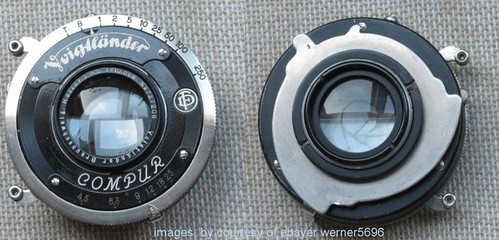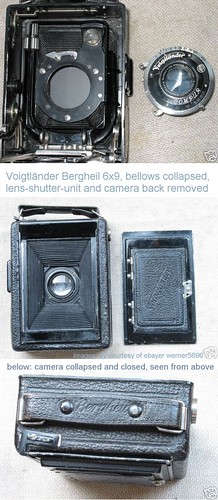Difference between revisions of "Bergheil"
(Rearranged one picture array (as I left it before, it spills when you narrow the screen)) |
(A few extra words at the top, tried making first two pictures bigger) |
||
| Line 1: | Line 1: | ||
__NOTOC__ | __NOTOC__ | ||
| + | |||
{| class="floatright plainlinks" style="text-align: center; margin:0px 0px 10px 15px;" | {| class="floatright plainlinks" style="text-align: center; margin:0px 0px 10px 15px;" | ||
| − | | [http://www.flickr.com/photos/rebollo_fr/4826108981/in/pool-camerawiki/ http://farm5.static.flickr.com/4073/ | + | |[http://www.flickr.com/photos/rebollo_fr/4826108981/in/pool-camerawiki/ http://farm5.static.flickr.com/4073/4826108981_f57e34d863.jpg] |
| + | |- | ||
| + | |[http://www.flickr.com/photos/rebollo_fr/4826108861/in/pool-camerawiki/ http://farm5.static.flickr.com/4136/4826108861_ed2df10caa.jpg] | ||
|- | |- | ||
| − | | | + | | 6.5×9cm Bergheil with 10.5 cm f/4.5 Heliar and dial-set Compur shutter, and<br/>with geared shift (note the red spirit level set in the end of the shift knob).<br/><small>Pictures by {{image author|eBayer Yalluflex}}.</small> {{with permission}} |
|} | |} | ||
| + | The '''Bergheil''' is a series of well-specified folding plate cameras made by [[Voigtländer]] in Braunschweig (Brunswick) from 1911 until the Second World War.<REF>These dates are given in [http://www.earlyphotography.co.uk/site/entry_C69.html notes on the Bergheil] at [http://www.earlyphotography.co.uk/index.html Early Photography]. </REF> It was available for a range of smaller plate sizes: 4.5x6 cm, 6.5x9 cm, 9x12 cm and 10x15 cm (the largest size is fairly unusual). It is metal-bodied, with leather covering. In some (but not all) examples, 'Bergheil' is impressed in the leather of the focusing screen, and/or in the carrying handle. | ||
| − | + | Most examples seen have a Compur shutter; early ones may be seen with a Compound, or even an [[Ibsor]] or [[Pronto]]. The cameras are equipped with a wide range of Voigtländer's own lenses; Heliar in particular are very common on later cameras. On later cameras, the lens and shutter may be interchangeable (attached with a bayonet). | |
| − | + | The cameras have rack-and-pinion bellows focusing, with a focusing knob on each side of the front of the bed. There is usually a focus scale on the left of the bed, and of course a ground-glass screen can be attached. They have front rise, adjusted with the knurled knob at the top of the right hand post of the front standard, and sometimes also geared shift. On many later cameras, there are red or yellow spirit levels inlaid in the focus and front-rise knobs. | |
| − | + | Almost all the cameras have a [[brilliant finder]] mounted on the lens standard; depending on the age and model, this may be mounted centrally above the lens (common especially on the smallest size), or offset to the left. Most cameras (except for the smallest) also have either a wire-frame finder or a folding [[Viewfinder#Newton finder|Newton finder]] on the side of the body. | |
| + | <br style="clear:both;"/> | ||
| − | |||
Revision as of 17:04, 22 January 2012

|

|
| 6.5×9cm Bergheil with 10.5 cm f/4.5 Heliar and dial-set Compur shutter, and with geared shift (note the red spirit level set in the end of the shift knob). Pictures by eBayer Yalluflex. (Image rights) |
The Bergheil is a series of well-specified folding plate cameras made by Voigtländer in Braunschweig (Brunswick) from 1911 until the Second World War.[1] It was available for a range of smaller plate sizes: 4.5x6 cm, 6.5x9 cm, 9x12 cm and 10x15 cm (the largest size is fairly unusual). It is metal-bodied, with leather covering. In some (but not all) examples, 'Bergheil' is impressed in the leather of the focusing screen, and/or in the carrying handle.
Most examples seen have a Compur shutter; early ones may be seen with a Compound, or even an Ibsor or Pronto. The cameras are equipped with a wide range of Voigtländer's own lenses; Heliar in particular are very common on later cameras. On later cameras, the lens and shutter may be interchangeable (attached with a bayonet).
The cameras have rack-and-pinion bellows focusing, with a focusing knob on each side of the front of the bed. There is usually a focus scale on the left of the bed, and of course a ground-glass screen can be attached. They have front rise, adjusted with the knurled knob at the top of the right hand post of the front standard, and sometimes also geared shift. On many later cameras, there are red or yellow spirit levels inlaid in the focus and front-rise knobs.
Almost all the cameras have a brilliant finder mounted on the lens standard; depending on the age and model, this may be mounted centrally above the lens (common especially on the smallest size), or offset to the left. Most cameras (except for the smallest) also have either a wire-frame finder or a folding Newton finder on the side of the body.
Bergheil De Luxe
Brown leather

|

|

| |

|

|
| Voigtländer Bergheil Luxus, 4×6.5cm, 7.5cm f/6.8 Doppel-Anastigmat Radiar lens, dial-set Compur shutter. Pictures by eBayer Yalluflex. (Image rights) | |
The true Bergheil Luxus (or De Luxe) from 1923-27 is finished with light brown leather covering and bellows, and has gold-finish standard and fittings, after the style of a tropical camera. It was only made in the 4.5x6cm size.
Green leather

|

|

| |
| Bergheil 6.5×9cm, with green leather, interchangeable 10.5cm f/3.5 Heliar and 25.5cm f/6.3 Tele-Dynar lenses and rim-set Compur shutter. An identical camera has also been seen with a 20 cm Tele-Dynar. Pictures by eBayer Yalluflex. (Image rights) | |
There are also cameras with textured green leather covering and bellows, but with the same black-painted fittings as the standard Bergheil. These are often described as 'de luxe' cameras. McKeown dates them to 1932-6 (some years after Voigtländer stopped making the brown-leather camera), and rather dismisses them as a step up from the black models, but [..] not truly 'Luxus' models; all 6.5x9cm and 9x12cm cameras after 1932 had this green leather. McKeown states that the green leather of the bellows tends to darken with age, so that the 'green' cameras are often not particularly green.[2]
 
|
 
|
   
|
| Voigtländer Baby Bergheil, 4.5×6cm, dial-set Compur shutter. Pictures by eBayer Yalluflex. (Image rights) |
Interchangeable lenses
Later Bergheil cameras have an exchangeable lens/shutter unit, attached via a bayonet. Many of the standard lenses are Heliars. The usual long-focus lens is the Tele-Dynar.

|
| Voigtländer Heliar 10.5cm f/4.5 lens and Compur shutter, with a bayonet mount for the Bergheil. (Image rights) |

|

|
| 25.5cm f/6.3 | 20cm f/6.3 |
| Voigtländer Tele-Dynar lenses. Pictures by eBayer Yalluflex. (Image rights) | |
Notes
- ↑ These dates are given in notes on the Bergheil at Early Photography.
- ↑ McKeown, James M. and Joan C. McKeown's Price Guide to Antique and Classic Cameras, 12th Edition, 2005-2006. USA, Centennial Photo Service, 2004. ISBN 0-931838-40-1 (hardcover). ISBN 0-931838-41-X (softcover). p950-1.
Links

|

|
|
In English: In English and German: |